brake light PORSCHE 911 2014 6.G Information Manual
[x] Cancel search | Manufacturer: PORSCHE, Model Year: 2014, Model line: 911, Model: PORSCHE 911 2014 6.GPages: 75, PDF Size: 11.41 MB
Page 11 of 75

2021
S
trength
| The 911 Carrera S
Its identity emerged on the racetrack.
Its home is on the road.
The 911 Carrera S.
Nothing defines us more than our heritage.
It says a lot about who we are. This is
particularly true of the 911 Carrera S,
which has all the characteristics you would
expect of a sports car whose origin is
in motorsport.
An elementary component of its DNA,
therefore, is power in the form of a 3.8-
litre engine with direct fuel injection (DFI)
and VarioCam Plus. It delivers 294 kW
(400 hp) at 7,400 rpm, and the maxi-
mum torque of 440 Nm is achieved
at 5,600 rpm. In conjunction with
the manual gearbox, the sprint from
0 to 100 km/ h is completed in a
mere 4.5 seconds. Top speed isn’t
reached until 304 km/ h.
On figures alone, the new 911 Carrera S
excels, particularly in terms of efficiency,
fuel consumption and CO
2 emissions.
This is made possible by the auto start /
stop function, which is available as
standard, and the coasting function
in conjunction with optional Porsche
Doppelkupplung (PDK).
It ’s not difficult to tell where the
911 Carrera S comes from. You can hear
it in the resonant engine sound and you
can see it in the t win tailpipes in brushed
stainless steel and 20 -inch Carrera S
wheels.
You can also feel it, thanks to Porsche
Active Suspension Management (PASM),
which is fit ted as standard, or the optional
PASM sports suspension with even
sportier aerodynamics and the ride height
lowered by 20 mm. Or the optional
Sport Chrono Package and dynamic
engine mounts. Available as standard,
Porsche Torque Vectoring (PTV), or
Porsche Torque Vectoring Plus (PTV Plus)
in conjunction with the optional PDK,
increase traction and driving stability.
Porsche Dynamic Chassis Control (PDCC),
the active roll stabilisation system, is
available as an option and improves
agility, comfort and safety.
On the subject of safet y, the brakes at
the front of the 911 Carrera S come
equipped with monobloc fixed calipers with six, instead of four, pistons for
improved braking performance and a
shorter braking distance. Bi-Xenon
headlights are standard, while the
Porsche Dynamic Light System (PDLS)
and LED main headlights including
Porsche Dynamic Light System Plus
(PDLS
+
) are available as options.
There is no doubt. The 911 Carrera S
knows its roots, and embraces them
with efficiency, power and sport y
performance.
For fuel consumption, CO
2 emissions and efficiency class, please refer to pages 141/143.
Page 13 of 75

2425
S
trength
| The 911 Carrera S Cabriolet
Porsche 356, Porsche 550, Porsche Carrera GT, Porsche 918 Spyder:
openness has always been a Porsche tradition.
The 911 Carrera S Cabriolet.
Open-top driving is integral to Porsche
history. It began back in 1948 with the
No. 1. The convertible variant of the
first 356 became a legend, as did its
descendent, the Porsche 550 Spyder.
In 1982, the first 911 Carrera model in
cabriolet form was introduced to the road.
Two things that all open-top Porsche cars
have in common are an urge for sport y
acceleration and unlimited driving
pleasure. The time has come to carry
this tradition on into the future. The
911 Carrera S Cabriolet does just that.
That explains what motivates us; so let ’s
describe what drives the car: the 3.8-litre
engine with direct fuel injection (DFI) and
VarioCam Plus, which produces
294 kW (400 hp) at 7,400 rpm. The
911 Carrera S Cabriolet completes
the sprint from 0 to 100 km/ h in just
4.7 seconds and reaches a top speed
of 301 km/ h.
These are impressive performance
figures, founded on the principle that, if
you want to keep moving, you shouldn’t
carry unnecessary weight. This is
precisely why the 911 Carrera S
Cabriolet incorporates the extensive
use of lightweight materials.
The fabric hood plays a crucial role in
this respect. Integrated, supporting
magnesium elements make the hood light yet extremely robust. The hood
opens and closes in just 13 seconds and
is operable up to a speed of 50 km/ h.
With the hood closed, the car’s profile is
optimised for aerodynamic performance,
which explains the low drag coefficient of
0.30. Wind noise is practically eliminated.
The integrated wind deflector manipulates
headwind to create ideal conditions.
Electrically powered and installed directly
behind the passenger cell, it provides effective protection against air turbulence.
Twin tailpipes in stainless steel also make
a clear statement. The 20 -inch Carrera S
wheels afford an unobstructed glimpse
of the brake calipers with a red painted
finish. As you would expect, the
911 Cabriolet offers a high level of
occupant safety and features an
effective roll-over protection concept
as well as full-size airbags for the
driver and front passenger.
Without question, the 911 Carrera S
Cabriolet has remained faithful to
the sporty spirit of its predecessors
and is ensuring that the legacy lives
on in the 21st century.
For fuel consumption, CO
2 emissions and efficiency class, please refer to pages 141/143.
Page 15 of 75
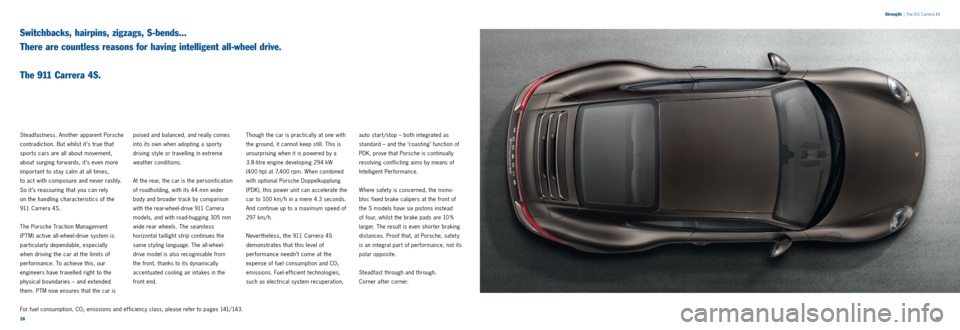
2829
Switchbacks, hairpins, zigzags, S-bends...
There are countless reasons for having intelligent all-wheel drive.
The 911 Carrera 4S.
Steadfastness. Another apparent Porsche
contradiction. But whilst it ’s true that
sports cars are all about movement,
about surging forwards, it ’s even more
important to stay calm at all times,
to act with composure and never rashly.
So it ’s reassuring that you can rely
on the handling characteristics of the
911 Carrera 4S.
The Porsche Traction Management
(PTM) active all-wheel- drive system is
particularly dependable, especially
when driving the car at the limits of
performance. To achieve this, our
engineers have travelled right to the
physical boundaries – and extended
them. PTM now ensures that the car is poised and balanced, and really comes
into its own when adopting a sport y
driving st yle or travelling in extreme
weather conditions.
At the rear, the car is the personification
of roadholding, with its 44 mm wider
body and broader track by comparison
with the rear-wheel- drive 911 Carrera
models, and with road-hugging 305 mm
wide rear wheels. The seamless
horizontal taillight strip continues the
same st yling language. The all-wheel-
drive model is also recognisable from
the front, thanks to its dynamically
accentuated cooling air intakes in the
front end.
Though the car is practically at one with
the ground, it cannot keep still. This is
unsurprising when it is powered by a
3.8-litre engine developing 294 kW
(400 hp) at 7,400 rpm. When combined
with optional Porsche Doppelkupplung
(PDK), this power unit can accelerate the
car to 100 km/ h in a mere 4.3 seconds.
And continue up to a maximum speed of
297 km/ h.
Nevertheless, the 911 Carrera 4S
demonstrates that this level of
performance needn’t come at the
expense of fuel consumption and CO2
emissions. Fuel-efficient technologies,
such as electrical system recuperation,
For fuel consumption, CO
2 emissions and efficiency class, please refer to pages 141/143.
S trength | The 911 Carrera 4S
auto start/stop – both integrated as
standard – and the ‘coasting’ function of
PDK, prove that Porsche is continually
resolving conflicting aims by means of
Intelligent Performance.
Where safety is concerned, the mono -
bloc fixed brake calipers at the front of
the S models have six pistons instead
of four, whilst the brake pads are 10 %
larger. The result is even shorter braking
distances. Proof that, at Porsche, safet y
is an integral part of performance, not its
polar opposite.
Steadfast through and through.
Corner after corner.
Page 21 of 75
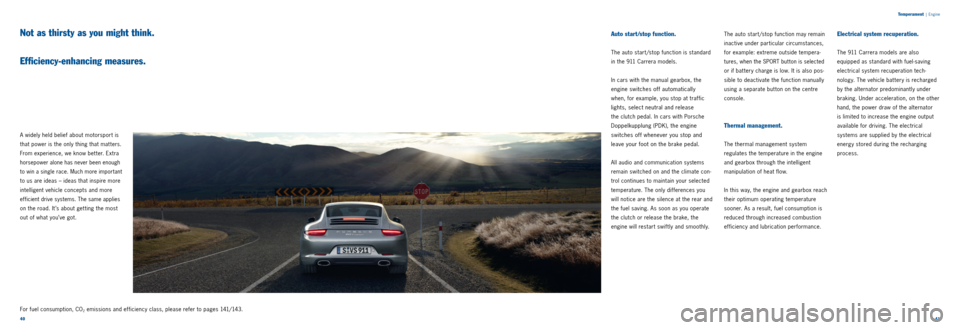
4041
A widely held belief about motorsport is
that power is the only thing that mat ters.
From experience, we know bet ter. Extra
horsepower alone has never been enough
to win a single race. Much more important
to us are ideas – ideas that inspire more
intelligent vehicle concepts and more
efficient drive systems. The same applies
on the road. It ’s about get ting the most
out of what you’ve got.
Auto start/stop function.
The auto start/stop function is standard
in the 911 Carrera models.
In cars with the manual gearbox, the
engine switches off automatically
when, for example, you stop at traffic
lights, select neutral and release
the clutch pedal. In cars with Porsche
Doppel kupplung (PDK), the engine
switches off whenever you stop and
leave your foot on the brake pedal.
All audio and communication systems
remain switched on and the climate con -
trol continues to maintain your selected
temperature. The only differences you
will notice are the silence at the rear and
the fuel saving. As soon as you operate
the clutch or release the brake, the
engine will restart swiftly and smoothly. The auto start/stop function may remain
inactive under particular circumstances,
for example: extreme outside tempera
-
tures, when the SPORT but ton is selected
or if bat tery charge is low. It is also pos -
sible to deactivate the function manually
using a separate but ton on the centre
console.
Thermal management.
The thermal management system
regulates the temperature in the engine
and gearbox through the intelligent
manipulation of heat flow.
In this way, the engine and gearbox reach
their optimum operating temperature
sooner. As a result, fuel consumption is
reduced through increased combustion
efficiency and lubrication performance.
Electrical system recuperation.
The 911 Carrera models are also
equipped as standard with fuel-saving
electrical system recuperation tech -
nology. The vehicle bat tery is recharged
by the alternator predominantly under
braking. Under acceleration, on the other
hand, the power draw of the alternator
is limited to increase the engine output
available for driving. The electrical
systems are supplied by the electrical
energy stored during the recharging
process.
T emperament | Engine
Not as thirsty as you might think.
Efficiency-enhancing measures.
For fuel consumption, CO2 emissions and efficiency class, please refer to pages 141/143.
Page 35 of 75

6869
Wheels.
The 911 Carrera models are equipped
with 19-inch Carrera wheels as standard.
These are light weight alloys featuring a
classic sport y design. Tyre sizes are
235/40 ZR 19 and 285/35 ZR 19 at the
front and rear, respectively. All-wheel-
drive models are fit ted with even wider
295/35 ZR 19 t yres at the rear.The S models are equipped with light-
alloy 20 -inch Carrera
S wheels as
standard. The visual effect is sport y and
dynamic. The t yres are slightly wider to
cope with the increased power output of
these models: 245/35 ZR 20 at the
front, 295/30 ZR 20 at the rear. All-
wheel-drive models have 305/30 ZR 20
t yres at the rear.
The large t yre size improves both ride
comfort and track performance. Rolling
resistance, dry braking distances and t yre
weight are all comparatively low, thereby
helping to reduce fuel consumption.
A selection of 20 -inch wheels is available
in our range of options.
Tyre Pressure Monitoring (TPM).
Integrated as standard, Tyre Pressure
Monitoring (TPM) sends warnings to the
on-board computer’s display screen in
the event of low t yre pressure or a
gradual or sudden loss of pressure. The
individual pressures in all four t yres can
be displayed in the instrument cluster.
Porsche Stability Management (PSM).
As standard, the 911 Carrera models are
equipped with enhanced Porsche Stability
Management (PSM), which maintains sta -
bilit y even at the limits of dynamic driving
performance. Sensors continuously moni -
tor the direction, speed, yaw velocit y and
lateral acceleration of the car. Using this
information, PSM is able to calculate the actual direction of travel at any given
moment. If the car begins to oversteer or
understeer, PSM applies selective braking
on individual wheels to restore stabilit y.
Under acceleration on wet or low-grip
road surfaces, PSM improves traction
using the automatic brake diffe
rential
(ABD) and anti -slip regulation (ASR).
When the SPORT PLUS mode of the
optional Sport Chrono Package is selected,
the PSM threshold is raised to allow a
sportier driving style.
For an even more dynamic experience,
you always have the option to deactivate
PSM. It is automatically reactivated,
for your safet y, only if you brake harder
and either of the front wheels (in SPORT
PLUS mode, both of the front wheels) requires ABS assistance. ABS and ABD,
however, remain active at all times.
PSM therefore offers a high level of
driving stability and safety combined
with extraordinary agilit y. It ’s an
apparent contradiction in terms, but an
intrinsic part of the Porsche identit y.
19 -inch Carrera wheel (standard on
the 911 Carrera models)
20-
inch Carrera S wheel (standard on
the 911 Carrera S models) 911 Carrera 4 Cabriolet with 20-inch Carrera Classic wheels
T
emperament | Chassis and body
For fuel consumption, CO2 emissions and efficiency class, please refer to pages 141/143.
Page 38 of 75
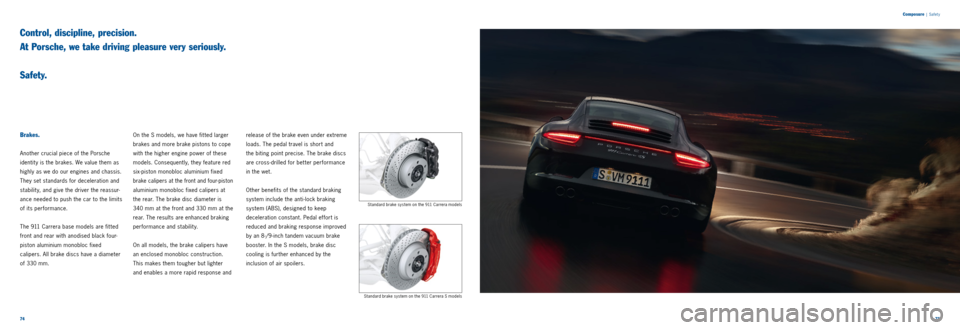
7475
Composure
| Safet y
Control, discipline, precision.
At Porsche, we take driving pleasure very seriously.
S a f e t y.
Brakes.
Another crucial piece of the Porsche
identit y is the brakes. We value them as
highly as we do our engines and chassis.
They set standards for deceleration and
stabilit y, and give the driver the reassur
-
ance needed to push the car to the limits
of its performance.
The 911 Carrera base models are fit ted
front and rear with anodised black four-
piston aluminium monobloc fixed
calipers. All brake discs have a diameter
of 330 mm. On the S models, we have fit ted larger
brakes and more brake pistons to cope
with the higher engine power of these
models. Consequently, they feature red
six-piston monobloc aluminium fixed
brake calipers at the front and four-piston
aluminium monobloc fixed calipers at
the rear. The brake disc diameter is
340 mm at the front and 330 mm at the
rear. The results are enhanced braking
performance and stability.
On all models, the brake calipers have
an enclosed monobloc construction.
This makes them tougher but lighter
and enables a more rapid response and release of the brake even under extreme
loads. The pedal travel is short and
the biting point precise. The brake discs
are cross-drilled for better performance
in the wet.
Other benefits of the standard braking
system include the anti-lock braking
system (ABS), designed to keep
deceleration constant. Pedal effort is
reduced and braking response improved
by an 8-/9-inch tandem vacuum brake
booster. In the S models, brake disc
cooling is further enhanced by the
inclusion of air spoilers.
Standard brake system on the 911 Carrera models
Standard brake system on the 911 Carrera S models
Page 39 of 75
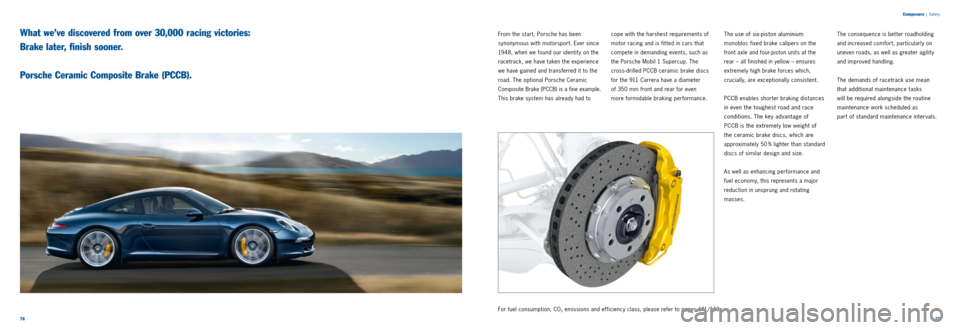
7677
From the start, Porsche has been
synonymous with motorsport. Ever since
1948, when we found our identit y on the
racetrack, we have taken the experience
we have gained and transferred it to the
road. The optional Porsche Ceramic
Composite Brake (PCCB) is a fine example.
This brake system has already had to
Composure | Safet y
cope with the harshest requirements of
motor racing and is fit ted in cars that
compete in demanding events, such as
the Porsche Mobil 1 Supercup. The
cross-drilled PCCB ceramic brake discs
for the 911 Carrera have a diameter
of 350 mm front and rear for even
more formidable braking performance. What we’ve discovered from over 30,000 racing victories:
Brake later, finish sooner.
Porsche Ceramic Composite Brake (PCCB).The use of six-piston aluminium
monobloc fixed brake calipers on the
front axle and four-piston units at the
rear – all finished in yellow – ensures
extremely high brake forces which,
crucially, are exceptionally consistent.
PCCB enables shorter braking distances
in even the toughest road and race
conditions. The key advantage of
PCCB is the extremely low weight of
the ceramic brake discs, which are
approximately 50 % lighter than standard
discs of similar design and size.
As well as enhancing performance and
fuel economy, this represents a major
reduction in unsprung and rotating
masses. The consequence is better roadholding
and increased comfort, particularly on
uneven roads, as well as greater agilit y
and improved handling.
The demands of racetrack use mean
that additional maintenance tasks
will be required alongside the routine
maintenance work scheduled as
part of standard maintenance intervals.
For fuel consumption, CO2 emissions and efficiency class, please refer to pages 141/143.
Page 40 of 75
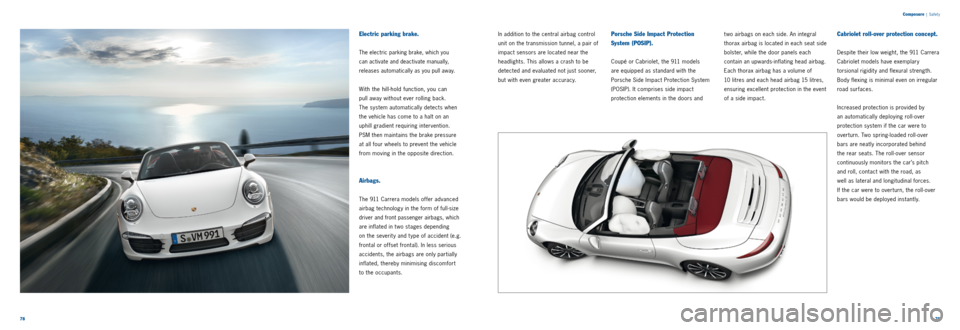
7879
Composure
| Safet y
Electric parking brake.
The electric parking brake, which you
can activate and deactivate manually,
releases automatically as you pull away.
With the hill-
hold function, you can
pull away without ever rolling back.
The system automatically detects when
the vehicle has come to a halt on an
uphill gradient requiring intervention.
PSM then maintains the brake pressure
at all four wheels to prevent the vehicle
from moving in the opposite direction.
Airbags.
The 911 Carrera models offer advanced
airbag technology in the form of full-size
driver and front passenger airbags, which
are inflated in t wo stages depending
on the severit y and t ype of accident (e.g.
frontal or offset frontal). In less serious
accidents, the airbags are only partially
inflated, thereby minimising discomfort
to the occupants. In addition to the central airbag control
unit on the transmission tunnel, a pair of
impact sensors are located near the
headlights. This allows a crash to be
detected and evaluated not just sooner,
but with even greater accuracy.
Porsche Side Impact Protection
System (POSIP).
Coupé or Cabriolet, the 911 models
are equipped as standard with the
Porsche Side Impact Protection System
(POSIP). It comprises side impact
protection elements in the doors and t wo airbags on each side. An integral
thorax airbag is located in each seat side
bolster, while the door panels each
contain an upwards-inflating head airbag.
Each thorax airbag has a volume of
10 litres and each head airbag 15 litres,
ensuring excellent protection in the event
of a side impact.
Cabriolet roll-over protection concept.
Despite their low weight, the 911 Carrera
Cabriolet models have exemplary
torsional rigidit y and flexural strength.
Body flexing is minimal even on irregular
road surfaces.
Increased protection is provided by
an automatically deploying roll-over
protection system if the car were to
overturn. Two spring-loaded roll-over
bars are neatly incorporated behind
the rear seats. The roll- over sensor
continuously monitors the car’s pitch
and roll, contact with the road, as
well as lateral and longitudinal forces.
If the car were to overturn, the roll- over
bars would be deployed instantly.
Page 41 of 75

8081
To see something coming, experience helps.
So does forward-looking technology.
Lights.
Composure | Safet y
The 911 Carrera models are equipped as
standard with Bi-Xenon headlights
including a headlight cleaning system
and dynamic range control. The LED
front light units incorporate indicators,
day time running lights and position
lights. Automatic headlight activation is
also included as standard.
Cut ting edge LED technology is also
used for the taillights, the high-level third
brake light, the licence plate illumination,
the rear direction indicators, the rear fog
light and – on all-wheel- drive models –
the rear light strip. LEDs provide bet ter
illumination and respond more quickly
to driver input.
In the event of sudden braking, the adap -
tive LED brake lights begin to pulsate.
If the vehicle is braked to a halt, the
hazard warning lights will switch on
automatically. The lighting system
fea tures an automatic switch-
off and
the ‘Welcome Home’ function.
Porsche Dynamic Light System (PDLS).
The Porsche Dynamic Light System
(PDLS) is available as an option. Its
dynamic cornering light function swivels
the headlights towards the inside of a
bend, based on steering angle and road
speed, in order to illuminate more of the
road at tight bends and turns. Put simply,
the road ahead is illuminated the moment
you enter a bend. Speed -sensitive head-
light range control is also part of the
PDLS as is the adverse weather function.
LED main headlights with Porsche
Dynamic Light System Plus (PDLS +
).
Superior safet y meets sport y design in
the form of the LED main headlights with
PDLS+ which are available as optional
equipment. Integrated into each headlight
housing are four LED spots for the
day time running lights, and one LED light
ring. In addition to being efficient and
long-lasting, LED technology also creates
a light very similar to daylight and thus
helps to reduce driver fatigue. One special feature of PDLS+ is the
dynamic main beam function. A camera
detects the lights of vehicles ahead
as well as those of oncoming traffic.
Based on the data from the camera, the
dynam
ic main beam function then adapts
the headlight range accordingly. This continu
ous, stepless control means that
you are able to see the course of the
road, pedestrians and potential hazards
earlier without hindering other road
users.
Rear night lighting Porsche Dynamic Light System (PDLS) cornering lights
Front night lighting
Page 46 of 75

9091
Composure
|
Comfort
Climate control.
The 911 models feature t wo -zone
automatic climate control as standard
with an enhanced ventilation effect and
separate temperature controls for the
driver and front passenger. The available
air conditioning modes are gentle,
normal and strong.
An active carbon filter traps particles,
pollen and odours and an automatic
air-recirculation function permanently
monitors air quality, reduces humidity
and switches from fresh to recirculated
air when required. A demister function
keeps the windows clear in cold weather. In warmer weather, a solar sensor helps
the climate control
to detect strong
sunlight and automatically
compensate
for the comfort of both the driver and
front passenger.
HomeLink® (programmable garage
door opener).
As an option, it is possible to have
a programmable garage door opener
integrated into the overhead console.
At the push of a but ton, it controls up
to three different garage doors, lighting
systems or alarm systems.
Many things have practical qualities.
Even more have a sporty function.
And some are just extremely convenient.
Additional comfort and convenience features.
Cruise control.
This automatic speed control function is
available as an option. For greater driver
comfort on long stretches of road, cruise
control operates in the 30 –240 km/ h
speed range and is activated using a but -
ton on the steering column control stalk.
Light design package.
The optional light design package is both
practical and aesthetically appealing.
It comprises dimmable LEDs in the over -
head console and in the areas of the
door pulls, door storage compartments,
front foot wells and rear seats.
‘Welcome Home’ lighting.
For convenience, particularly at night,
the ‘Welcome Home’ lighting function
automatically switches on the LED day -
time running lights for a defined period
whenever the vehicle is opened or
closed using the key remote.
A customisable delayed switch- off timer
keeps the day time running lights, the
taillights and, where applicable, the
courtesy lights switched on until you
reach your front door.
Adaptive cruise control with Porsche
Active Safe (PAS).
Available as an option, this cruise control
function regulates your speed according
to the distance bet ween your vehicle and
the vehicle in front. A radar sensor moni -
tors the road ahead up to a distance of
200 m. If you have set a cruising speed
but have begun to gain on the vehicle in front because it is driving more slowly,
this is detected by the radar sensor.
The system now reduces the speed
of your vehicle at a maximum rate of
3.5 m/sec
2 by restricting the throt tle
or by applying the brakes appropriate
to the prevailing situation until the dis -
tance that you have preset is maintained.
Your vehicle will now continue at a reduced speed. If the other vehicle
decelerates further, adaptive cruise
control will continue to reduce your
cruising speed – even down to a halt. For additional safet y, if the system detects
that the distance from the vehicle in front
is decreasing, it will also prepare your
vehicle for braking by precharging the
braking system so that the brake pads are already in light contact with the
brake discs. However, drivers still have
to perform heavier braking themselves.
As soon as the road ahead clears again,
your vehicle will accelerate back up to
the cruising speed originally set.
If your vehicle approaches the vehicle
in front too quickly, Porsche Active Safe
(PAS) will issue audible and visual warn
-
ings. In addition, the system briefly jerks
the brakes and if necessary initiates
target braking, with any braking pressure
applied by the driver being increased
within certain system limits.
Adaptive cruise control display
Radar sensor of adaptive cruise control